

Aztec Calendar: Today in the Aztec and Maya Calendar. Aztec Religion - AZTEC GODS - Aztecs of Mexico History. AZTEC RELIGION AZTEC STUDENT RESEARCH GUIDE (C)1997-2005 (Thomas H.
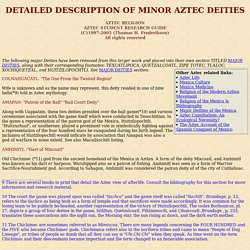
Frederiksen) All rights reserved The following major Deities have been removed from this larger work and placed into their own section TITLED MAJOR DEITIES, along with their corresponding footnotes: TEXCATLIPOCA, QUETZALCOATL, ZIPE TOTEC, TLALOC, XOCHIQUETZAL, and HUITZILOPOCHTLI. See MAJOR DEITIES section. COLNAHUACATL- "The One From the Twisted Region" Wife is unknown and as the name may represent, this deity resided in one of nine hells(*9) told in Aztec mythology. Aztec Day Signs Regular. Jaguar Sun: The Maya people of the past and present. Maya Aztec Inca. Aztec Inca Maya Power Point. WEB SITES RELATED TO THE AZTECS, INCA AND MAYA. Websites Lesson Plans & Classroom Activities Webquests Access these sites through your computer’s Internet connection.
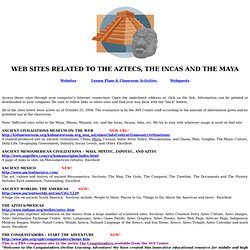
Open the underlined address or click on the link. Information can be printed or downloaded to your computer. Be sure to follow links to other sites and find your way back with the "back" button. All of the sites listed were active as of October 25, 2004. Systems: Meso Americano Font Bundle. Aztec Day Signs Regular. Aztec Religion - AZTEC GODS - Aztecs of Mexico History. Aztec Calendar: Today in the Aztec and Maya Calendar. Aztec Religion. Aztecs and the Aztec Civilization. Aztec Gods and Goddesses - Ancient / Classical History. Huitzilopochtli Huitzilopochtli was the Aztec god of the obsidian knife who sprang forth from his mother's belly to kill his siblings.
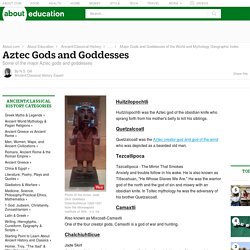
Quetzalcoatl. Aztec History. P B S : C o n q u i s t a d o r s - C o r t é s. In the decade before the Spanish arrived in Mexico, Aztec Emperor Montezuma II and his people were filled with a sense of foreboding.

A series of evil omens had foretold of calamities to come. A fiery comet crossed the sky. The temple of Huitzilopochtli, the god of war, burst into flames. Aztecs. The first European to visit Mexican territory was Francisco Hernandez de Cordoba, who arrived in Yucatan from Cuba with three ships and about 100 men in early 1517.

Cordobars reports on his return to Cuba prompted the Spanish governor there, Diego Velasquez, to send a larger force back to Mexico under the command of Hernan Cortes. In March 1519, Cortes landed at the town of Tabasco, where he learned from the natives of the great Aztec civilization, then ruled by Moctezuma (or Montezuma) II. Aztec Civilization. The Aztec Empire flourished between c. 1345 and 1521 CE and, at its greatest extent, covered most of northern Mesoamerica.
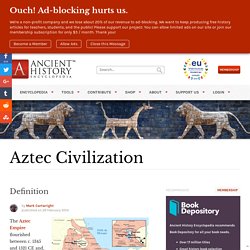
Aztec warriors were able to dominate their neighbouring states and permit rulers such as Motecuhzoma II to impose Aztec ideals and religion across Mexico. Highly accomplished in agriculture and trade, the last of the great Mesoamerican civilizations was also noted for its art and architecture which ranks amongst the finest ever produced on the continent. The Aztec state is actually the most well documented Mesoamerican civilization with sources including archaeology, native books (codices) and lengthy and detailed accounts from their Spanish conquerors - both by military men and Christian clergy. History of Mexico - The Aztec Empire. THE RISE OF THE AZTEC EMPIRE By John P.
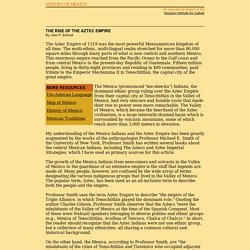
Schmal The Aztec Empire of 1519 was the most powerful Mesoamerican kingdom of all time. The multi-ethnic, multi-lingual realm stretched for more than 80,000 square miles through many parts of what is now central and southern Mexico. This enormous empire reached from the Pacific Ocean to the Gulf coast and from central Mexico to the present-day Republic of Guatemala. BBC Bitesize - KS2 History - The Aztec Empire.
The Aztec Civilization. Was the Aztec Empire Really All Powerful? Aztec Calendar : Mexico Culture & Arts. Dale Hoyt Palfrey Mexica/Aztec Calendar Systems The Civil Calendar.

Nahuatl (Aztec) Family. The Nahuatl (or Nahua) languages form the southernmost family of the Uto-Aztecan stock.
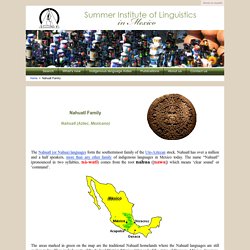
Nahuatl has over a million and a half speakers, more than any other family of indigenous languages in Mexico today. The name “Nahuatl” (pronounced in two syllables, ná-watl) comes from the root nahua ([nawa]) which means ‘clear sound’ or ‘command’. The Aztec Capital City of Tenochtitlan - Aztec Culture. Greatest Aztec. Image above by Guido Galvani and María Sánchez Vega, courtesy Templo Mayor project, National Institute of Anthropology and History, MexicoPhotographs by Kenneth Garrett and Jesús López On the edge of Mexico City's famed Zócalo plaza, next to the ruins of the Aztec sacred pyramid known as the Templo Mayor, the remains of an animal—perhaps a dog or a wolf—were discovered.

It had been dead for 500 years and lay in a stone-lined shaft eight feet deep. It is likely the animal had no name, nor an owner. Aztec mythology. Aztec Math Decoded, Reveals Woes of Ancient Tax Time. April 3, 2008 Today's tax codes are complicated, but the ancient Aztecs likely shared your pain. To measure tracts of taxable land, Aztec mathematicians had to develop their own specialized arithmetic, which has only now been decoded. By reading Aztec records from the city-state of Tepetlaoztoc, a pair of scientists recently figured out the complicated equations and fractions that officials once used to determine the size of land on which tributes were paid. Beginner's Guide to the Aztec Empire of Central Mexico. Aztecs (Mexica) During the twelfth century AD the Mexica were a small and obscure tribe searching for a new homeland. Eventually they settled in the Valley of Mexico and founded their capital, Tenochtitlan, in 1345. At the beginning of the sixteenth century it was one of the largest cities in the world.
Tarlton Law Library - Aztec and Maya Law - online exhibit. The Aztec empire was made up of a series of city-states known as altepetl. Each altepetl was ruled by a supreme leader (tlatoani) and a supreme judge and administrator (cihuacoatl). The tlatoani of the capital city of Tenochtitlan served as the Emperor (Huey Tlatoani) of the Aztec empire. Introduction to the Aztecs exhibition: Melbourne Museum. A pot in the shape of Tláloc, the Aztec rain god. Tláloc is a Nahuatl word that translates as 'He Who Makes Things Sprout'.Image: Michel ZabeSource: Consejo Nacional para la Cultura y las Artes - Instituto Nacional de Antropología e Historia Canny conquerorsTalented artisansHeart-stopping ritualsA nasty ending Aztecs is an exhibition about a highly organised civilisation and the spectacular city it created - Tenochtitlán (pronounced Teh-notch-tit-lan).
Visit Melbourne Museum from 9 April until 10 August 2014 and discover the Aztecs’ ingenious agricultural technology, bustling trade and array of gods. There are stories of war, the arrival of Spanish explorers, how Cortés the conquistador met Moctezuma the Aztec ruler, and yes, human sacrifice. People. Aztec Civilization. Aztec Religion. The Aztec World. A kingdom of blood. SEP, Department of Education. The capital city of the Aztecs, Tenochtitlán, was an engineering masterpiece.
Aqueducts and canals snaked through the city, channelling pure water to possibly 200,000 inhabitants each day. In 1978, while digging in the basement of a bookstore, workers for Mexico City's power company hit a huge stone disk. Almost 11 feet across, engraved on its surface was the dismembered body of Coyolxauhqui, the Aztec moon goddess.